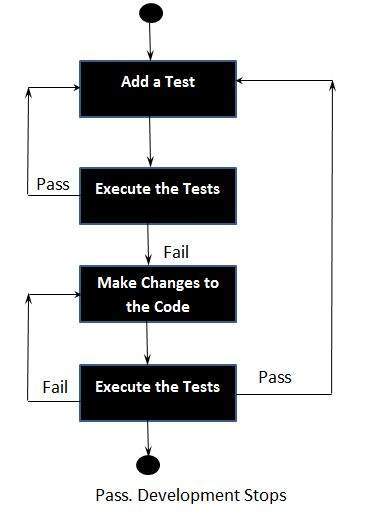
- Software Testing Dictionary
- Home
Software Testing - Code Driven Testing
What is Code Driven Testing?
The Code driven testing also known as test driven development's first step is to add a test, which is enough for code to fail. Next, we execute out tests usually a complete test suite or a subset of tests to accelerate testing to ensure that the new test fails. Then, the code is updated to make it pass the new tests. Then, the fourth step is to execute the tests again. If they fail, we need to update the code and retest. Once the test passes, the next step is to go through the same process again for the next development item.
Thus the software code driven testing involves designing of the unit test cases for a feature of a software in pipeline for development (i.e where the code development has not yet started). As the development has been completed, those unit test cases are executed against the code. If the tests have failed, the developed code is updated, and the retesting continues till all the unit test cases have passed successfully. Once the whole process has been completed, the next set of unit test cases are designed for the following feature in the queue for development.
Workflow of Software Code Driven Testing
The workflow of the software code driven testing is described below −

Step 1 − Create a comprehensive test case which is capable of verifying the software code. In the software code driven testing, the developers make a guess on which sections of the code there is a possibility of failure, and accordingly the test cases are designed such that they have a higher probability of failing the developed code.
Step 2 − The code is executed against those unit test cases, and then verified if those are failing.
Step 3 − If the result is a pass, then the code is confirmed to work as expected and the code development is taken as completed for that section of the developed code.
Step 4 − If the code has really failed as per the developer’s guesses, then the code has to be rectified until all those unit test cases have passed.
Step 5 − Run the same test case against the updated code, and analyze the outcome.
Step 6 − Once all the unit tests have passed, then the next section of the code is taken up and the same process is repeated.
Advantages of Software Code Driven Testing
The advantages of the software code driven testing are listed below −
- The software code driven testing is a good approach to verify the public interfaces of the software.
- The software code driven testing helps to achieve a good code coverage and develop a stable, secure, and trustworthy software.
- The software code driven testing involves execution of the unit test cases to verify every nook and corner of the software code.
- The software code driven testing detects errors in the early stages of the SDLC.
- If software code driven testing is adopted in the development process, then it helps to develop the code for test automation very quickly. As developers are contributing towards the test activities, they are getting the opportunity to improve their testing skills simultaneously. This ultimately helps to improve the ability of the complete team.
Conclusion
This concludes our comprehensive take on the tutorial on Software Code Driven Testing. We’ve started with describing what is a software code driven testing, what is the workflow of the software code driven testing, and what are the advantages of the software code driven testing. This equips you with in-depth knowledge of Software Code Driven Testing. It is wise to keep practicing what you’ve learned and exploring others relevant to Software Testing to deepen your understanding and expand your horizons.